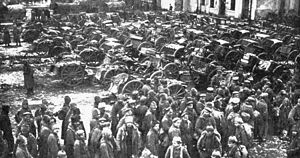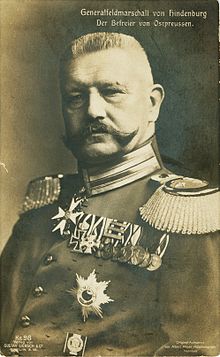Battle of Tannenberg
Battle of Tannenberg
Part of: World War I

Russian prisoners after the battle of Tannenberg
Major military operations on the
Eastern Front (1914-1918)
1914East Prussian
operation (Stallupönen, Gumbinnen, Tannenberg, Masurian Lakes) - Galicia (Kraśnik, Komarów, Gnila Lipa, Lemberg, Rawa Ruska) - Przemyśl - Vistula - Kraków - Łódź - Limanowa-Lapanow - Carpathians
1915Humin
- Masuria - Zwinin - Przasnysz - Gorlice-Tarnów - Bug Offensive - Narew Offensive - Great Retreat - Novogeorgievsk - Rovno - Svenziany Offensive
1916Lake Narach
- Brussilov Offensive - Baranovichi Offensive
1917Aa
- Kerensky Offensive (Zborów) - Tarnopol Offensive - Riga - Albion Enterprise
1918Operation
fist punch
The Battle of Tannenberg was a battle of World War I and took place in the area south of Allenstein in East Prussia from 26 August to 30 August 1914 between German and Russian armies. The German side fielded 153,000 men, the Russian side 191,000 soldiers. It ended with a victory for the German troops and the crushing of the Russian forces that had penetrated into southern East Prussia.
Initially referred to in the German media as the "Battle of Allenstein", it was renamed the Battle of Tannenberg for propaganda purposes shortly afterwards at the request of Paul von Hindenburg. In fact, it is not the village of Tannenberg (today Stębark) that lies directly in the main battle area, but Hohenstein. The naming was intended to outshine the defeat of the knights of the Teutonic Order against the Polish-Lithuanian Union in 1410, which is referred to in German historiography as the Battle of Tannenberg.
Strategic requirements
→ Main article: Eastern Front (World War I)
East Prussia's geographical position as a territorial advance into Russian territory made it a particularly vulnerable position strategically. Due to Russia's inferior infrastructure, the Schlieffen Plan assumed that if France and Russia declared war simultaneously, France would be able to mobilize four weeks faster. Therefore, the entire army force was to be sent against France first. The German Supreme Army Command stationed seven armies on the Western Front to bring about a quick victory against France. However, due to the July crisis, which Russia had already used to mobilize, the situation was exactly the opposite. The province was defended only by the 8th Army and was therefore particularly vulnerable because of the low troop strength. The Russian Grand Headquarters had already taken this circumstance into account in its pre-war planning. In order to relieve its western allies, the Russian High Command sent two armies against East Prussia. The 1st Army (Nyemen Army) under Paul von Rennenkampff advanced from the east, the 2nd Army (Narew Army) under Alexander Samsonov entered East Prussia from the south.
During the first days of the operation, this strategy seemed to work. The Russian 1st Army advanced into East Prussian territory and achieved a first breakthrough after the Battle of Gumbinnen on August 19. The Russian General Staff expected the Germans, who had only one army available in East Prussia, to retreat across the Vistula. At first this assessment also seemed to prove true: The commander-in-chief of the 8th Army, Colonel General von Prittwitz, was unsettled and signaled by telephone to the Supreme Army Command in Koblenz that the army would withdraw behind the Vistula. Although this was in accordance with the directive to act, Chief of Staff General von Moltke believed Prittwitz was no longer up to the situation.
On the night of 22 August, he was suddenly and unexpectedly made available to his entire staff. He was to be succeeded by retired General of the Infantry Paul von Hindenburg with Major General Erich Ludendorff as Chief of Staff. Ludendorff, who had already distinguished himself on the Western Front in the capture of Liège, was immediately whisked by motor transport from the Namur area to the Grand Headquarters at Koblenz, where he arrived at about 6 p.m. A special train, into which Hindenburg boarded at Hanover, then conveyed him eastward. At noon the next day the generals reached their destination Marienburg.
For both generals, a "non-combat" evacuation of the Prussian province was out of the question. Unaware of this change, the Russian High Command, after the German troops had broken off the Battle of Gumbinnen, now proceeded on the assumption that East Prussia would be evacuated. The 1st Army was put on the march with Königsberg as its objective, in order to tie up the 8th Army. The 2nd Army was to retreat and "fall in the rear" of the enemy thus bound. Thus, both large units moved spatially separated from each other and could hardly provide support to each other. Another reason for the spatial separation of the 1st Army from the 2nd Army was that between their operational areas lay the impassable Masurian Lake District.

Paul von Hindenburg
Double sided deployment
The Russian 2nd (Narew) Army had by this time penetrated to within 60 kilometers of the Soldau - Neidenburg - Ortelsburg line in southern East Prussia. As eastern flank protection the VI Army Corps under General of Infantry Blagoweschtschenski (4th and 16th Divisions) with the 4th Cavalry Division advanced on Ortelsburg, as western flank protection the I Army Corps with allotments and two cavalry divisions from Usdau to Soldau. The western center battle group, consisting of the XV Army Corps under Lieutenant General Klujew (6th and 8th Divisions) and one additional division, fought from Lippau to Orlau, and the eastern center battle group, consisting of the XIII Army Corps under General of the Infantry Martos (1st and 36th Divisions), stood west of Jedwabno. General von Ludendorff followed Max Hoffmann's plan of attack, already worked out, which provided for fighting the two Russian armies one after the other in time. This was intended to counterbalance the numerical superiority of the Russians. Hoffmann's plan called for attacking first the Russian 2nd Army under General Alexander Samsonov, which was penetrating from the south. The choice of attacking this army first rather than the Russian 1st Army was motivated by the intention of preserving the possibility for the German 8th Army to retreat - westward - across the Vistula in the event of its own defeat. This was only guaranteed if the battle area was not too far to the east.
Even before Hindenburg took command, the I Army Corps under General Hermann von François von Gumbinnen had been moved by rail to the south west of the Russian 2nd Army's axis of advance. Having been informed of the enemy's positions as well as orders by aerial reconnaissance and interception of unencrypted Russian radio transmissions, General von Ludendorff also set in motion a general movement of the rest of the army away. The Russian 1st Army was to be observed in the Insterburg to Lötzen area by a small "curtain" of several Landwehr brigades and the 1st Cavalry Division and prevented from continuing its operations. The XVII Army Corps under August von Mackensen and the I Reserve Corps under Otto von Below began to break away from their section and march against the right flank of the Russian 2nd Army operating in the direction of Allenstein.
The German plan was facilitated by a miscalculation on the part of the Russian commanders. General Rennenkampff did not react until three days after the beginning of the German regroupings initiated on 23 August by resuming his own attack operations, which pointed in the direction of Königsberg. The front commander of the superior Russian northwestern front, General Yakov Shilinsky, also completely misinterpreted German behavior at this time: in the certain belief that German units were retreating before the 1st Army pressure on Königsberg, he did not exercise caution. That the German troops might turn against the southern 2nd Russian Army he did not consider.
During these events, Samsonov's army had already completed its tenth day of marching, since by order of the front staff, for security reasons, the troops had already been unloaded from the railway cars deep in their own rear and had to march the rest of the way on foot. However, only the central parts (XIII, XV and XXIII Corps) and the right wing (VI Corps) of the army were moving in German territory. On the left wing, I Corps was held back on the border by order of Shilinsky to cover the flank. Further, the Supreme Commander urged a rapid advance of the 2nd Army, which completely separated the center and its western flank. Thus, here the planned flank protection became the isolation of a quarter of the Russian forces.
Since August 22, the right wing of the German 8th Army, the XX Army Corps under General of Artillery von Scholtz, retreated to the northwest before the superiority of the Russian XIII and XV Corps across the Usdau-Neidenburg line. On the evening of August 23, the 37th Division came into first fights with the Russian vanguard between Lahna and Orlau. On the left wing, the XX Corps had been reinforced by General von Morgen's 3rd Reserve Division, which was advancing from Allenstein via Hohenstein. Scholtz received instructions the following day to hold his new position defensively between Gilgenburg and Tannenberg until the advance of the I Reserve Corps and the XVII Army Corps in the enemy's rear became effective. On the right wing of the German 8th Army, after the long rail transport via Deutsch-Eylau, the I Army Corps of General François positioned itself last, without the reconnaissance of the opposing Russian I Corps noticing this.

Alexander Vasilievich Samsonov

Situation on 20 August 1914
Search within the encyclopedia